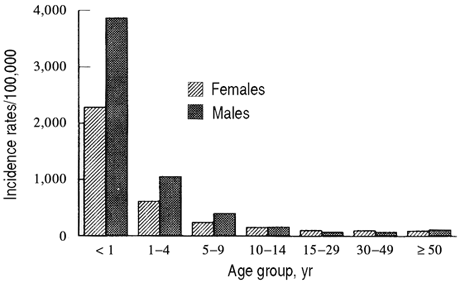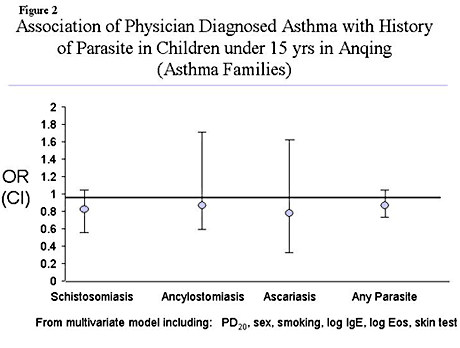Partners Asthma Center Grand Rounds
Scott T. Weiss, M.D.
Epidemiology of Asthma
Today I will plan to review with you information regarding trends in asthma prevalence, hospitalizations, and deaths. I will share with you from the perspective of an epidemiologist my view of the natural history of asthma. I will speak about the role of parasitic and other infections in the etiology of asthma, and conclude with speculation about the direction that research into risk factors of asthma will be taking in the next few years.
The prevalence of asthma in the United States, based on phyician diagnosis of asthma, is increasing dramatically. Office visits to physicians for asthma have more than doubled over the last 15 years. The actual prevalence of asthma is estimated to have risen almost three-fold. As one looks to other industrialized nations in the Western world, this trend is not confined to this country. Well-done studies performed in Aberdeen, Scotland by the research team of Dr. Peter Helms assessed the prevalence of asthma among young children in 1964 and then again, in another cohort of children of the same age, 25 years later. They used the same survey methodology both times, and they chose an age range (8-13 years old) where a diagnosis of asthma would not be confounded either by the transient wheezing found among very young children or by irreversible airflow obstruction caused by cigarette smoking or other conditions of adulthood. What they found was an approximately 80% increase in asthma prevalence and an almost 400% increase in other atopic diseases, suggesting that increases in allergic sensitization may in part be driving the asthma epidemic in the Westernized world.
Data reported by the Centers for Disease Control in Atlanta indicate increases in asthma prevalence among all age groups, but the most striking rates of rise are among younger children. In the older age groups changes in disease coding may have confounded the results and account for some of the observed increases. With the last revision in disease coding, patients with asthmatic bronchitis, who used to be coded as chronic bronchitis and chronic obstructive pulmonary disease, began to be coded as asthma. Among persons less than age 35, this coding change is not a confounder, and in this age group the increases in asthma prevalence have been dramatic.
If anything, medical practices are likely to bias toward underdiagnosis of asthma among children. For one thing, it is difficult for a pediatrician to know whether wheezing at an early age will continue. Forty percent of all children have wheezing in the first year of life, whereas by age 3 only 18% have wheezing. Second, calling a condition "wheezy bronchitis" or "reactive airways disease" is likely to save time for the busy practitioner compared to a diagnosis of "asthma," which feels more serious and will take more explanation to concerned parents. Third, a diagnosis of asthma establishes a "pre-existing condition." In a medical world where half of all persons enrolled in managed care will change their managed care plan within 3 years, the presence of a pre-existing condition may complicate a family's ability to obtain their desired health care.
Asthma Hospitalizations and Mortality
The trends in hospitalizations and mortality for asthma are similar, with notable increases throughout the 1980s and 1990s. The results in the United States are again mirrored by international statistics for asthma hospitalizations. Asthma mortality also rose during this same time period, including in persons between ages 5 and 34, where diagnostic bias is less of an issue. In the United States, asthma mortality is highest among African Americans and closely related to socioeconomic disadvantage. Deaths from asthma in the United States are relatively few, just over 5000 per year, compared to approximately 500,000 deaths each year from coronary artery disease. The impact of asthma on mortality may be greater if one believes, as I do, that asthma is a precursor and risk factor for the development of chronic obstructive pulmonary disease (COPD). COPD is the 4th leading cause of death in the United States and the most rapidly rising cause of death among persons over age 65. However, the greatest impact of asthma is not mortality but the morbidity that it causes. Asthma is the leading cause of hospitilizations in children; it is the leading cause for days lost from school for children; and it is probably a leading cause of days lost from work for adults, who need to stay home with a sick asthmatic child.
Overall, mortality rates for asthma are low. Increases in mortality have been seen at all ages, and the rates are highest among persons living in our inner cities. Rising mortality rates have been observed not only in the United States but also in other countries with systematic data collection. Clearly, as the number of people with the disease increases, adverse outcomes — including hospitalizations and deaths — will also increase. This trend is particularly true in the United States, where lack of an nationally organized healthcare system leaves a large number of perople without access to the advantages associated with advances in treatment. The disadvantaged poor, who disproportionately populate the inner cities, are most vulnerable.
Areas Spared the Asthma Epidemic
The asthma epidemic is not worldwide. For example, asthma prevalence is low throughout Africa. As one looks at asthma prevalence over the African continent as a whole, one finds a gradient in prevalence that increases as one goes from poor to less poor and from rural to urban. We found the same relationships in China, where we are currently doing research in the region of Anqing City in the province of Auhui.. The prevalence of asthma in this region is approximately 1% or between 6 and 30 times less than the prevalence in industrialized countries. As one goes from the farming communities to the ancient capital city in this province, the prevalence of asthma increases to approximately 2-3%, and in Beijing it is approximately 5%. This finding has been universal: asthma prevalence rises as living conditions become more urban and Westernized.
The Natural History of Asthma
Dr. John Yunginger, an allergist at Mayo Clinic, reported on the age of onset of asthma among persons living in Olmsted County in Minnesota. Persons in this study lived in this county all of their lives, and their medical records were reviewed to determine when they first were diagnosed with asthma. The key point is that 80-90% of all asthma has its onset in early childhood, (Figure 1) an observation that has some very important implications for the natural history of this disease. The first point relates to etiology. Factors involved with the inception of asthma in early childhood (and possibly even in utero) may be different from those that we identify as associated with progression, remission, or exacerbations of established disease later in life. For instance, most of the known association between asthma and allergic exposures relates to the perpetuation of established disease. Little is known relating allergen exposure and disease inception early in life. If we want to study the causes of asthma, we will need now to focus on the environmental exposures of the neonate and infant.
For the clinician, a relevant conclusion from data on the age of onset of asthma is that most asthma presenting in late childhood and early adulthood is probably a recurrence rather than incident disease. After all, our memory of events before age 6 is very poor. Knowing that there is a strong genetic component to asthma and that the prevalence of wheezing in the first year of life is 40%, it is likely that for most adults their asthma first manifested in infancy but that they have no recollection and did no receive a diagnostic label of asthma at that time.
The complexity of the situation is evident when one considers two additional factors. First, the intermediate phenotypes for asthma — elevated total and specific IgE, skin test reactivity, and airway hypperresponsiveness — are 3-5 times more prevalent in the population than clinical disease in childhood and early adulthood. Second, throughout early childhood the lungs grow, and, in general, increases in lung function correlate inversely with clinical symptoms. Research into the causes of asthma needs to encompass all of these aspects: asthma is a pediatric disease, a developmental disease, an immunologic disease, a genetic disease, and an environmental disease.
Infections and asthma
An immunologic model for the development of asthma emphasizes the importance of the T helper lymphocyte type 2 (TH2) cells and the cytokines that they produce. TH2 lymphocytes predominate in allergic responses, where as TH1 lymphocytes participate in fighting infections. Although the dichotomy is probably less distinct than suggested by this model, the important point is that environmental factors, particularly infections, can influence immune system development, immunologic memory, and the pattern of cytokine production. Differences in exposures to infectious agents in early childhood may influence immune system ontogeny and help to explain differences in asthma prevalence around the world.
Two hypotheses are offered to explain the development of asthma. The first hypothesis suggests that early exposure to bacterial, viral, or mycobacterial infection pushes the immune system toward the TH1 response and protects against the development of the TH2 response. In support of this hypothesis are data indicating an inverse correlation between measles infection and allergy skin test reactivity in Guinea- Bissau, and BCG vaccination and PPD skin test positivity being associated with a lower risk of developing allergies in Japan. The second hypothesis raises the possibility that an overexuberant expression of the TH2 response, such as in response to parasitic infection, might protect against the development of allergies. As a general point, this area of investigation — how environmental exposures, whether infections or air pollution or diet or allergen — interact with each other and with the developing immune system to induce the TH2 phenotype is the current direction of epidemiologic research into the etiology of asthma.
Parasitic infections
The literature on allergies and parasitic infections seems to provide evidence on both sides: that parasitic infections might protect from or predispose to the development of atopy. Ecologic data correlating the prevalence of parasitic infections and the prevalence of asthma in various countries indicate an inverse correlation, but this is weak evidence for cause and effect. In pursuit of this hypothesis a British physician with severe hay fever infected himself with tapeworm; his hay fever promptly resolved. By what mechanism might parasitic infection protect against asthma?
Parasitic infection is a potent stimulus fro the production of IgE antibodies. The blocking antibody theory suggests that high levels of IgE stimulated by parasitic infections bind up available receptors on mast cells and basophils, leaving no open receptors to which allergens can attach.
As part of our genetics of asthma study in China, in collaboration with Dr. Xi Ping Xu, Director of the program for Population Genetics at the Harvard School of Public Health, we screened people in five counties for the presence of parasitic infections and for asthma. Based on the results of a pilot study, we focused on three parasites: ascaris, ancylostomiasis, and schistosomiasis. We also tested skin test reactivity to common local allergens and measured serum IgE levels.
Parasitic infection by ancylostomiasis correlated negatively with the presence of a doctor's diagnosis of asthma, but overall, considering all the parasitic infections, the protective effect was not statistically significant. (Figure 2) Likewise, the presence of parasitic infection had no significant effect on skin test reactivity to common allergens. Unlike in the Westernized world, in China, as has also been found in Ethiopia, skin test reactivity and total serum IgE level do not predict the presence of asthma as a disease. The presence or absence of parasitic infections had little effect on the total IgE level; and, in general, all of the subjects screened had relatively high IgE levels, in the range that would predict atopic disease in Westernized countries. This dissociation between allergy phenotypes (skin test reactivity and high serum IgE level) and clinical asthma makes evident that the relationship between allergy and asthma is not uniform throughout the world.
One final point about infections and asthma relates to our living conditions in relation to farm animals. A recent article in the New York Times described the mini-epidemic that occurred in upstate New York when bacteria from one cow's manure seeped into a well that supplied water to several vendors at a local fair. Several persons fell ill, and one child died from E. coli sepsis. This outbreak reminds us that an important contrast between rural upstate New York and rural China is indoor plumbing and the sewage system. In rural China animal manure enters the water system all the time, and children are frequently exposed from birth to E. coli and to a multitude of other pathogens. For Chinese babies to survive in that environment, their level of adaptive and passive immunity must be far greater than is found in this country.
In fact, over the last 5000 years humans in general have lived in close proximity to domesticated farm animals. Endotoxin exposure from these animals is likely to have been one of the mechanisms by which we developed a natural immunity so that we could survive this close contact. Endotoxin exposure is also likely to have an important effect on the early development of the immune system, influencing the balance between the expression of TH1 and TH2 cells and cytokines.
In a broader sense, we are reminded that the contrast between
China and industrialized countries in the West involves a variety
of different factors. Obesity, use of antibiotics, diet,
parasitic infections, endotoxin exposure, and air pollution
— all of these factors may be important in explaining the
differences between developing countries and industrialized
countries with regard to the prevalence of asthma. It is worth
noting that these risk factors look far more like the risk
factors for coronary artery disease and other chronic complex
traits than traditional asthmatic risk factors, such as allergen
exposure. As we look forward to future epidemiologic research
into the etiologies of asthma, effective strategies will need to
focus on genetically susceptible populations, early life
exposures, and disease development using longitudinal cohorts and
a multi-disciplinary approach. Immunologists and epidemiologists
will need to collaborate with geneticists and pathobiologists to
understand how environmental exposures early in life influence
development of the immune system and expression of the phenotypes
associated with asthma.
References:
Ninan TK, Russell G. Respiratory symptoms and atopy in Aberdeen schoolchildren: evidence from two surveys 25 years apart. BMJ 1992; 304:873-5.
Yunginger JW, Reed CE, O'Connell EJ, et al. A community-based study of the epidemiology of asthma: incidence rates, 1964-1983. Am Rev Respir Dis 1992; 146:888-94.
Weiss ST. Parasites and asthma/allergy: what is the relationship? J Allergy Clin Immunol 2000; 105 (2 Pt 1):205-10.
About the Author: Dr. Scott Weiss directs the Program on Respiratory, Environmental, and Genetic Epidemiology at the Channing Laboratory, Brigham and Women's Hospital. He is Professor of Medicine at Harvard Medical School and a member of the faculty at Brigham and Women's Hospital.

Figure 1: Annual incidence rates of definite and probable asthma according to age of onset in Olmsted County, Minnesota, 1964-1983. Hatched bars = females; shaded bars = males.

Figure 2. Association of physician diagnosed asthma with history of parasite in children under 15 years in Anqing (asthma families).

